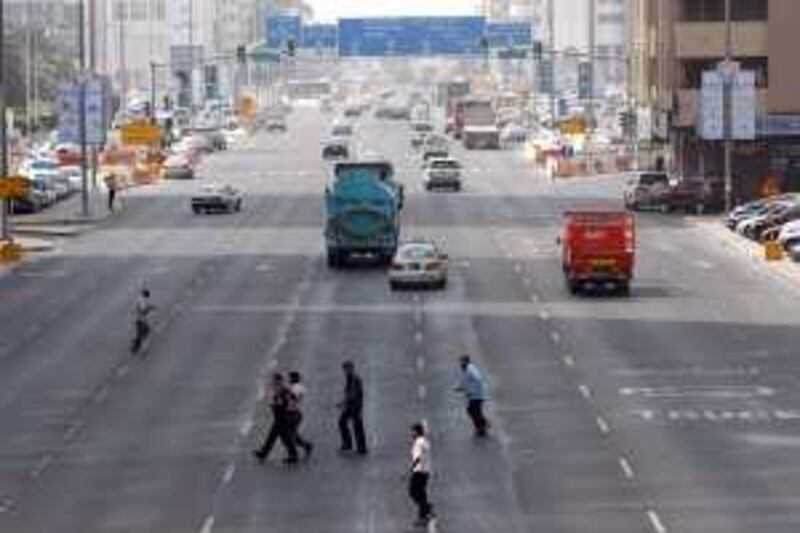Outside Abu Dhabi Mall, a Bangladeshi man yanks an errant jaywalker back as a crush of lorries thunders by. A Lebanese mother races through the traffic with a baby stroller, then struggles to mount the high pavement at the other end. An elderly woman briefly considers crossing alone, amid screaming car horns, before scurrying behind a group of labourers. And all the while, a steel footbridge nearby - designed to provide safe passage for the jaywalkers risking their lives below - appears conspicuously unused. In the streets of Abu Dhabi, pedestrian infrastructure appears to do little to dissuade people from darting through high-speed traffic. Yesterday The National monitored a footbridge, an underpass and a zebra crossing, and found pedestrians routinely ignoring the safer passageways. In one hour outside Abu Dhabi Mall, only 80 people climbed the stairs to use the steel footbridge; 134 preferred to make a mad dash across six lanes. Kussai al Najjad, the manager of Ettihad Antiques Gallery across from the mall, sees the scene every day. "Look at these ones now," he said, pointing out a group of women sprinting across the road with bags of groceries. "This is so dangerous. Why does nobody use the bridge when it is right here?" Mr Najjad, 33, of Syria, said he had witnessed at least two accidents at the crossing in the past two months. "Maybe 10 days ago, one lady - she was driving and she hit a guy who was stuck in the middle trying to cross the street," he said. "I saw he was laying down on the street, with blood. Then the police came." Mr Kussai acknowledged that although he makes a habit of using the bridge, doing so could be arduous for others. One employee with the Abu Dhabi Co-operative Society noted that it would be impossible for him to carry grocery trolleys up and down several flights of stairs to customers' cars. He obtained a permit from the police allowing him to cross the intersection legally if he is pushing a trolley. Omar Farook of India said he jaywalked because he suffered from back pain and could not climb too many steps. "I wait for signal and I cross this way, because this bridge is too far," said Mr Farook, 40. "Sometimes I feel sick and this is bad for my back." Jane Hernandez, 50, from the Philippines, walks to the mall for weekly grocery shopping. She began using the bridge several months ago after seeing a lorry mow down a jaywalker. "It was really horrible. I saw one Filipina, she was hit by a big trailer. I heard she had three operations," Mrs Hernandez said. "It's easier to cross here [at the bridge] because I'm afraid of the cars going by very fast." Like others, she complained that the bridges were not accessible enough, especially for pedestrians who were often hauling shopping bags while they cross. Col Gaith al Zaabi, the director of the Ministry of Interior's traffic department, said in April that municipalities needed to do more to protect pedestrians and should take a far tougher stance against drivers and jaywalkers who flouted the law. Surveillance cameras should be installed in underpasses, as many women were too scared to use them, particularly at night, he said. Col al Zaabi, who oversees traffic in the emirate, also called for underpasses and bridges to be made accessible to people with special needs. In a bid to encourage more people to use the overpasses, Abu Dhabi Municipality announced this week it would install automatic lifts in several bridges, including the one overlooking Abu Dhabi Mall. Elsewhere, on Electra Street across from Hamed Centre, Wasim Abdulmotaleb wondered whether air-conditioned lifts could also be brought to the nearest pedestrian tunnel. "If inside the underpass we have a lift, then no problem," the Bangladeshi sales clerk said. Mr Abdulmotaleb, 26, admitted to jaywalking regularly, jogging to the central divide and squeezing through a hole in the fence facing the Hamed Centre. He was among one of at least 159 people observed doing the same thing, while 193 people crossed safely underground in the same hour. A Dh200 (US$54) fine for jaywalking from several months ago has not deterred him, nor has an injury to a friend who was struck by a car crossing the same road last week, breaking a bone in his foot. Convenience outweighed risk when it came to business, he reasoned. "When I am under shift and I have a customer calling me, only I know that I have to open quickly, quickly," Mr Abdulmotaleb said. Norm Labbe, the managing director of the Emirates Institute for Health and Safety, pointed out that "attractive underpasses" do exist, such as those along the Corniche. Even so, many people often forego safety to spare themselves a few steps. The underpass on Electra Street is only about 60 paces from the Hamed Centre entrance. "If you were to do a survey, it would likely reveal that pedestrians simply don't want to put in the effort of a couple more steps," said Mr Labbe, who has worked as a traffic safety consultant for the Abu Dhabi Police. "They're willing to risk their lives and also put vehicles in jeopardy because they want to take the short cut, and there's a whole mindset that needs to be changed." That also means exercising caution when recognising pedestrians' rights of way. Although zebra crossings are meant to be designated spots for people to walk through safely with the flow of traffic, drivers rarely acknowledge them. Over the course of an hour at a zebra crossing on Airport Road, not one vehicle stopped to allow any of 67 awaiting pedestrians to walk through. One van slowed down to allow a group of eight to proceed. Down the street, on both sides of the zebra crossing, The National saw 57 jaywalkers. Sabith Abdullah, 27, from India, mused that the legal crossing was essentially as perilous as jaywalking. "You can cross because there is zebra marks, but nobody stops," he said, shielding his eyes from the sun as cars whizzed by. "If the cars see this line, they should stop or slow down. They do not." Road policing and enforcement could help correct some poor driving habits, but Mr Labbe stressed that traffic safety was a two-way street. Pedestrians should behave responsibly too, he said. "Can we just put the blame on drivers? Not really," he said. "You can be a very safe and conscientious driver and still encounter dangers on the roads several times throughout your journey to and from home, from pedestrians darting in front of you to other unsafe drivers." mkwong@thenational.ae
Running risks to save a few steps
Abu Dhabi's roads do have underpasses, bridges and designated crossings. So why are so many pedestrians ignoring safer avenues?

Editor's picks
More from the national





